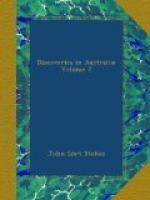We heard with great satisfaction that Lieutenant Emery’s search for water had been completely successful, and that two large wells had been dug in the valley, abreast of which the ship was anchored. During our absence the barometer had ranged between 30.08 and 29.97; the minimum height being always at noon. There had been several sharp squalls from the eastward, beginning at south-east and ending at north-east, with a few showers of rain. North-west, or seabreezes, were regular near the changes of the moon, and of greater duration. No meteors were observed since the 16th, but between the 7th and 11th they were very numerous.
Geological specimens.
November 20.
I went ashore to collect a few geological specimens: the sandstone which prevailed everywhere was in a decomposed state, but there was a very decided dip in the strata to the south-east, of about 30 degrees. On the east side of Water Valley, I found the same kind of slate, noticed before at Curiosity Peak: but what most interested me was a bituminous substance found near the bottom of the wells recently dug, and 23 feet from the surface of the ground. It was apparently of a clayey nature when first brought up, but became hard and dark upon exposure to the air, and ignited quickly when put into the flame of a candle. The sides of Water Valley were very precipitous, and nearly 300 feet high: a growth of palms marked the spot, and served to indicate our wells. We here saw also the same fruit I had noticed on Curiosity Peak.
Bird’s playhouse.
I found matter for conjecture in noticing a number of twigs with their ends stuck into the ground, which was strewed over with shells, and their tops brought together so as to form a small bower; this was 2 1/2 feet long, 1 1/2 foot wide at either end. It was not until my next visit to Port Essington that I thought this anything but some Australian mother’s toy to amuse her child: there I was asked, one day, to go and see the bird’s playhouse, when I immediately recognised the same kind of construction I had seen at the Victoria River: the bird* was amusing itself by flying backwards and forwards, taking a shell alternately from each side, and carrying it through the archway in its mouth.
(Footnote. Figured in Mr. Gould’s work as Chlamydera nuchalis.)
November 22.
The moon being full to-day we noticed that the tides were very strong: particularly the flood-stream, which came in bores, and sometimes swept by the ship at the rate of 6 1/2 knots, while the ebb did not exceed 4 1/2: the greatest rise also to-day was 24 feet.
Singular change of winds.
November 25.




